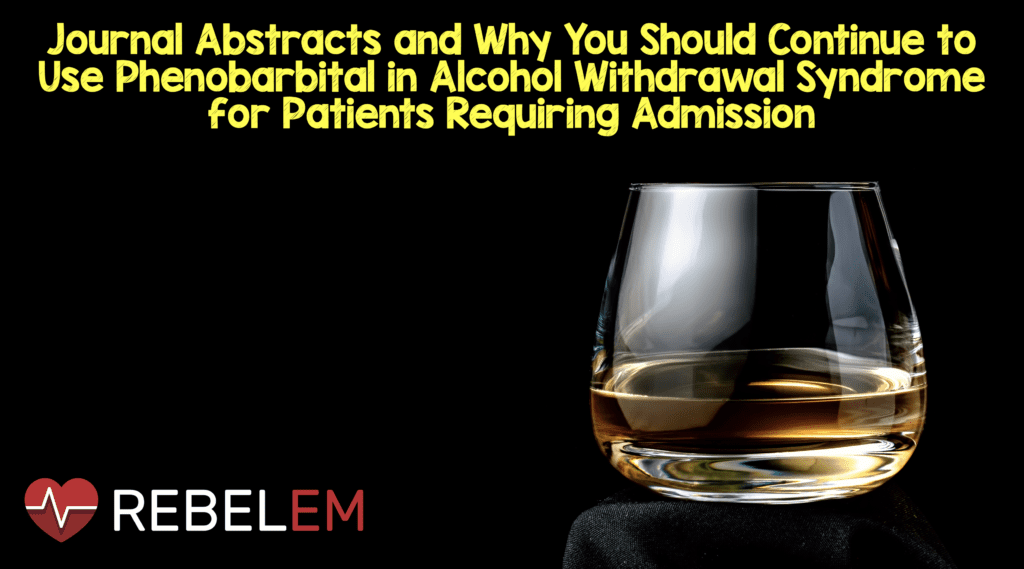
 Background: The mainstay of treatment for alcohol withdrawal syndrome is a symptom-triggered approach using benzodiazepines. Phenobarbital, however, is an interesting agent in this scenario for several reasons. It is famous for it is long duration of action. IV Phenobarbital has an onset of action of over 15 – 20 minutes, a duration of action of 10 – 12 hours and a half-life of 53 – 118 hours in adults [5]. But phenobarbital has several other characteristics that make it attractive in the treatment of alcohol withdrawal. Importantly, it works on the GABA receptor differently than benzodiazepines. First, it increases the duration (not frequency) the chloride channel is open. Also, chronic alcohol abuse can alter the GABA receptor making it less sensitive to benzodiazepines not barbiturates. And finally, at very high doses, phenobarbital can open the chloride channel independent of the presence of GABA. The authors of this paper sought to compare a phenobarbital-adjunct versus benzodiazepine-only approach for the management of alcohol withdrawal syndrome in the ED.
Background: The mainstay of treatment for alcohol withdrawal syndrome is a symptom-triggered approach using benzodiazepines. Phenobarbital, however, is an interesting agent in this scenario for several reasons. It is famous for it is long duration of action. IV Phenobarbital has an onset of action of over 15 – 20 minutes, a duration of action of 10 – 12 hours and a half-life of 53 – 118 hours in adults [5]. But phenobarbital has several other characteristics that make it attractive in the treatment of alcohol withdrawal. Importantly, it works on the GABA receptor differently than benzodiazepines. First, it increases the duration (not frequency) the chloride channel is open. Also, chronic alcohol abuse can alter the GABA receptor making it less sensitive to benzodiazepines not barbiturates. And finally, at very high doses, phenobarbital can open the chloride channel independent of the presence of GABA. The authors of this paper sought to compare a phenobarbital-adjunct versus benzodiazepine-only approach for the management of alcohol withdrawal syndrome in the ED.
What They Did:
- Multicenter retrospective cohort study conducted in two academic EDs in the USA
- Phenobarbital group (with or without benzodiazepines) vs non-phenobarbital group
Outcomes:
- Primary: Need for ICU admission
- Secondary:
- Clinical Institute Withdrawal Assessment for Alcohol (CIWA-Ar) score at ED discharge
- Complications (Composite of death, need for intubation, hypotension, vasopressor use, seizures, and hospital acquired pneumonia)
Inclusion:
- All adult patients ≥18 years of age who presented to the ED with a primary diagnosis of AWS
Exclusion:
- Did not receive phenobarbital or benzodiazepines for treatment of AWS in the ED
Results:
- 209 patients included in the study
- Randomly selected from 3586 eligible patients using a random number generator until the desired sample size was reached
- Phenobarbital group = 97 patients
- Non-Phenobarbital group = 112 patients
- Patients in the phenobarbital group received a median first dose of 260mg (IQR 130 – 500mg)
- Patients in the phenobarbital group received a median cumulative dose of 260mg (IQR 218 – 650mg) while in the ED
- 79/97 (81%) of patients in the phenobarbital group also received benzodiazepines
- Required ICU Admission:
- Phenobarbital: 14%
- Non-Phenobarbital: 11%
- P = 0.529
- Occurrence of Complications:
- Phenobarbital: 9%
- Non-Phenobarbital: 11%
- No patients died in the ED or during hospitalization
- ED Length of stay and ICU length of stay was similar between groups
Strengths:
- Other medications used between groups appeared similar
- Vital signs were similar between groups prior to medication administration
Limitations:
- Retrospective chart review of patients, meaning the results are only as good as the documentation in the charts (i.e. accuracy of documentation in the EMR)
- No drug therapy protocol in place for the management of AWS in the ED (i.e. medication selection, timing of medication, and dosing based on provider preference).
- Possible there was selection bias – Patients who received phenobarbital were more likely to have a history of alcohol withdrawal seizures and also had a higher total bilirubin, meaning providers may have been more likely to use phenobarbital in patients they expected to experience more serious AWS
- A lower dose of phenobarbital was used in this study compared to previous studies, which may be the main reason why no patient benefit was seen, why there were limited complications seen, and possibly failure to see reduction in benzodiazepine dose
- Exclusion of patients receiving oral phenobarbital likely unnecessary, and likely selects a sicker population of patients receiving phenobarbital than all-comers.
- Admission to the ICU (primary outcome) will depend on the hospital protocol more than anything else.
- CIWA score may not have reliable inter-user reliability (RASS score would have been a better score to use).
- Higher alcohol levels in the phenobarbital group could possible lead to increased complications due to oversedation
Discussion:
- Benzodiazepine use was measured in lorazepam equivalents using the following ratios: 5mg diazepam = 2mg midazolam = 10mg chlordiazepoxide = 1mg lorazepam equivalents
- One thing not mentioned in the results is that the median total use of benzodiazepines, although not statistically significant, was less in the phenobarbital group (Ativan equivalents = 14mg vs 22mg). What is more important here is safely getting patients with alcohol withdrawal syndrome to a sedation endpoint without overdoing it (i.e. LOS and ICU admission).
- A previous trial of 102 patients with AWS in the ED were randomized to 10mg/kg phenobarbital vs placebo and then placed on a lorazepam based protocol. Not only is this dose higher than the current study being reviewed but the ICU admission was also lower (8% vs 25%) [2].
- One thing not mentioned in this study was that lorazepam use may exclude some of the small benefits (active metabolite, less delirium) associated with diazepam use. [3]
- In my practice, I am using a 260mg bolus of IV phenobarbital followed by 130mg and another 130mg if needed q15 – 20min in addition to a lorazepam or lorazepam equivalent (i.e. many prefer diazepam for its fast onset which enables q5 min redosing, and its active metabolite which increases its effective duration of action) CIWA protocol
- Phenobarbital has the added benefit of a self-tapering effect for patients ok for discharge home (as does diazepam).
- At Bellevue, patients with AWS syndrome are given a big dose of Librium (100 mg) as the background and then a symptom triggered titrated valium PRN is used in addition. They found that Librium reduced the use of other BZD and patients did better/shorter ICU stays
Author Conclusion: “Adjunctive phenobarbital use in the ED for alcohol withdrawal syndrome did not result in decreased ICU admission, severity of symptoms, or complications.”
Clinical Take Home Point: Due to the low doses of phenobarbital used, lack of a drug therapy protocol, and the retrospective observational nature of this study, the authors conclusions should be taken with a grain of salt (We may just be looking at two groups where two different drugs were used poorly). This is another reason and reminder, why just reading an abstract is not good practice. The addition of a weight-based (10mg/kg ideal body weight) or dose-escalation protocol (260mg, 130mg, 130mg) has been shown to have improved patient-oriented outcomes, and therefore the results of this study will not change my practice of continuing to use phenobarbital in my AWS patients in the ED.
Expert Peer Reviewed By
 Meghan Spyres MD
Meghan Spyres MD
Assistant Professor of Clinical Emergency Medicine
Department of Emergency Medicine, Division of Medical Toxicology
LAC+USC Medical Center
Los Angeles, CA
Twitter: @mbspyres
 Jeff Lapoint, DO
Jeff Lapoint, DO
Department of Emergency Medicine, Division of Medical Toxicology
Kaiser Permanente San Diego
San Diego, CA
Twitter: @lapizity
References:
- Sullivan SM et al. comparison of Phenobarbital-Adjunct versus Benzodiazepine-Only Approach for Alcohol Withdrawal Syndrome in the Emergency Department. AJEM 2018. PMID: 30414743
- Rosenson J et al. Phenobarbital for Acute Alcohol Withdrawal: A Prospective Randomized Double-Blind Placebo-Controlled Study. J Emerg Med 2013. PMID: 22999778
- Michael F et al. Management of Alcohol Withdrawal Delirium: An Evidence-Based Practice Guideline. Archives of Internal Medicine 2004. PMID: 15249349
- Riggan MA et al. Regarding “Phenobarbital for Acute Alcohol Withdrawal: A Prospective Randomized Double-Blind Placebo-Controlled Study.” JEM 2016. PMID: 27221017
- Goldfrank’s Toxicologic Emergencies 10th Chapter 81.
- Loscher W et al. How Theories Evolved Concerning the Mechanism of Action of Barbituates. Epilepsia 2012. [Link is HERE]
For More Thoughts on This Topic Checkout:
- Core EM: Episode 57.0 – Phenobarbital in Alcohol Withdrawal
- PulmCrit: Phenobarbital Monotherapy for Alcohol Withdrawal – Reloaded
Post Peer Reviewed By: Anand Swaminathan, MD (Twitter: @EMSwami)
The post Journal Abstracts and Why You Should Continue to Use Phenobarbital in Alcohol Withdrawal Syndrome for Patients Requiring Admission appeared first on REBEL EM - Emergency Medicine Blog.
